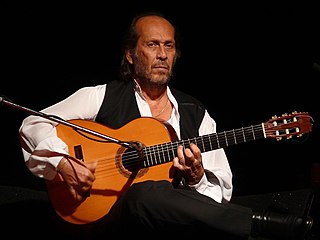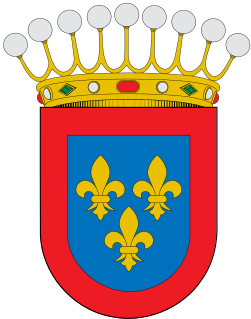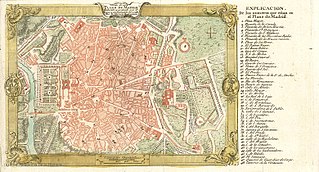This article needs additional citations for verification .(June 2017) (Learn how and when to remove this template message) |
Hermanos Conde (Conde Brothers) are luthiers, makers of classical and flamenco guitars.
This article needs additional citations for verification .(June 2017) (Learn how and when to remove this template message) |
Hermanos Conde (Conde Brothers) are luthiers, makers of classical and flamenco guitars.
The Conde dynasty was founded in Madrid by Domingo Esteso in 1915. Esteso trained his nephews Faustino and Mariano Conde Sr. Later, the young Julio Conde joined his brothers.
Domingo Esteso died in 1937, and after that time the three Conde Brothers continued working for Esteso's widow under the name of "Viuda y Sobrinos de Esteso" (Esteso's Widow and Nephews) until 1960. [1]
In the early 1950s, Julio Conde set up a new handicraft guitar center.
From 1960 until 1988-89 they took over the shop and called themselves "Sobrinos de Domingo Esteso Conde Hermanos" (Esteso's Nephews, Conde Brothers) or "Hermanos Conde Sobrinos de Domingo Esteso" (Conde Brothers, Esteso's Nephews).
Mariano Sr. later established his own shop close to the Royal Theatre, calling it "Conde Hermanos Sucesores Sobrinos de Esteso". His two sons, Felipe, born in 1957 and Mariano Jr., born 1959, began their apprenticeship with their father and uncle Faustino when they were about 15 years old. Faustino died in 1988 and Mariano Sr. in 1989.
Felipe and Mariano Conde (sons of Mariano Conde Sr.) manufactured flamenco guitars in their workshop at Felipe V St. nº 2 in Madrid close to the Teatro Real (Royal Theatre) and the Palacio Real (Royal Palace). They were known as "Conde Hermanos Sucesores Sobrinos de Esteso" (Conde Brothers - Esteso's Nephews Successors)
Felipe and Mariano have now broken off their business association. They work in different workshops and sell different models of guitars.
Felipe Conde works with his son and daughter Felipe Jr. and María at his shop at Arrieta 4, in front of the Royal Theatre, close to the old shop. Mariano Conde works at his shop at Amnistía 1, next to the Opera metro station.
Meanwhile, Julio carried on making guitars until his death in 1995, and now his sons and granddaughter maintain the tradition of "Conde Hermanos" at Atocha 53.

Famous Flamenco guitarists such as Mario Escudero, Oscar Herrero, Paco de Lucía, Melchor de Marchena, Andrea Nannetti, Niño Ricardo, Rafael Riqueni, Sabicas, Esteban de Sanlucar, Regino Sainz de la Maza and guitarists with other styles such as David Byrne, Leonard Cohen, Jesse Cook, Al Di Meola, Bob Dylan, Toninho Horta, Steve Howe, Lenny Kravitz, Meiko, Cat Stevens or John Williams have played with Hermanos Conde guitars.

Flamenco, in its strictest sense, is an art form based on the various folkloric music traditions of southern Spain, originating in the region of Andalusia, but also having a historical presence in Extremadura and Murcia. In a wider sense, the term is used to refer to a variety of Spanish musical styles. The oldest record of flamenco music dates to 1774 in the book Las Cartas Marruecas by José Cadalso. Although Flamenco is often associated to the Gitano ethnicity who have contributed significantly to its development, its origin and style are uniquely Andalusian and Flamenco artists have historically included Spaniards of both gitano and non-gitano heritage.

Gipsy Kings are a group of flamenco, salsa, and pop musicians from Arles and Montpellier in the south of France, who perform in a mixture of languages, mostly in Spanish, but also mixing southern French dialects. Although the group members were born in France, their parents were mostly gitanos, Spanish Romani who fled Spain during the 1930s Spanish Civil War. They are known for bringing rumba flamenca, a pop-oriented music distantly derived from traditional flamenco music, to worldwide audiences. The group originally called itself Los Reyes.

Francisco Gustavo Sánchez Gómez, known as Paco de Lucía, was a Spanish virtuoso flamenco guitarist, composer, and record producer. A leading proponent of the new flamenco style, he was one of the first flamenco guitarists to branch into classical and jazz. Richard Chapman and Eric Clapton, authors of Guitar: Music, History, Players, describe de Lucía as a "titanic figure in the world of flamenco guitar", and Dennis Koster, author of Guitar Atlas, Flamenco, has referred to de Lucía as "one of history's greatest guitarists".
Domingo Esteso (1882–1937) was a luthier who trained under Manuel Ramírez. His nephews, Faustino, Mariano and Julio Conde inherited his workshop and changed the name to Conde Hermanos. Nowadays, the family tradition established by Domingo Esteso is being continued at their workshops in central Madrid by Felipe Conde at 4 Arrieta St., Mariano Conde at 1 Amnistia St. next to Opera metro station and Julio Conde's sons and granddaughter at 53 Atocha St.

Ramírez Guitars is a Spanish manufacturer of professional, concert-quality classical and flamenco guitars. Five generations of the Ramírez family have produced Ramirez guitars.
Mario Escudero Valero Jiménez Valverde was one of a handful of Spanish flamenco guitar virtuosos who helped spread flamenco beyond their homeland when they migrated to the United States in the early 1950s. After completing his obligatory military service in Spain, he toured with the best known companies at the time. Eventually, his lifetime childhood friend, Juan Antonio Aguero, married Carmen Amaya, and Mario married her sister Maria, with whom he had a son. He soon travelled to the US as first soloist.

The saeta is a revered form of Spanish religious song, whose form and style has evolved over many centuries. Saetas evoke strong emotion and are sung most often during public processions.
Julio Conde was a Spanish luthier trained by his uncle Domingo Esteso at his workshop in Madrid, where Julio worked with his brothers Faustino y Mariano, establishing Hermanos Conde trademark.

Paco de Lucía y Ramón de Algeciras en Hispanoamérica is the third of four collaboration albums by Paco de Lucía and his brother Ramón de Algeciras.

En vivo desde el Teatro Real is a live album by Paco de Lucía recorded on February 18, 1975 at the Teatro Real in Madrid, Spain. He was accompanied by his brother Ramón de Algeciras on stage.

Count of Chinchón is a title of Spanish nobility. It was initially created on 9 May 1520 by King Charles V, Holy Roman Emperor, who granted the title to Fernando de Cabrera y Bobadilla.
José María Martín Domingo (1889–1961) was a Spanish composer and musician. He was born in Mahón on 23 May 1887 and died in Madrid on 16 July 1961.
Events of 2014 in Spain
Pío Caro Baroja was a Spanish film and television director, screenwriter, and author.

The Walls of Felipe IV surrounded the city of Madrid between 1625 and 1868. Philip IV ordered their construction to replace the earlier Walls of Philip II and the Walls del Arrabal, which had already been surpassed by the growth of population of Madrid. These were not defensive walls, but essentially served fiscal and surveillance purposes: to control the access of goods to the city, ensure the collection of taxes, and to monitor who went in and out of Madrid. The materials used for construction were brick, mortar and compacted earth.

Rolando Valdés-Blain was a Cuban classical guitarist, born in Havana, and immigrated to New York as a child. In the 1930s he and his brother Alberto had a weekly music show on WNYC radio. He served in Burma from 1942 to 1946 during World War II and afterwards studied at the Madrid Royal Conservatory, where he was awarded the Grand Prize for concert guitar playing by Joaquín Rodrigo. He toured worldwide under the management of impresario Sol Hurok and his United States tours as guitar soloist included Yale University, Carnegie Recital Hall, and the Spanish Ballet. He was one of the pioneering classical guitarists to perform as soloist together with a symphony orchestra, in 1955 with the Radio City Music Hall Symphony Orchestra and the Joffrey Ballet at the New York City Center. He appeared in Tennessee Williams's Broadway play Camino Real and he also composed the music for the play Bullfight. He was vice-president and adviser of Manuel Velazquez guitars and founder of the Guitar Department at the Manhattan School of Music. In 1968 he was invited to give a command performance at the White House. The New York Times called his performance "a musical gem…reflecting every baroque nuance of the music".

Princess Christian of Hanover, née Alessandra Lisette de Osma Foy is a Peruvian attorney, handbag designer, and former model. She is a member of the Hanoverian royal family through her marriage to Prince Christian of Hanover.
Manuel Ramírez was a Spanish luthier.
Antonio Gento López was a Spanish professional footballer who played as a forward.
Julio Gento López was a Spanish professional footballer who played as a forward.